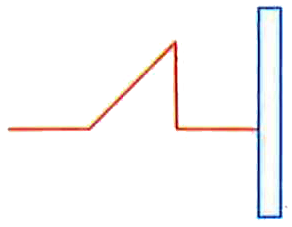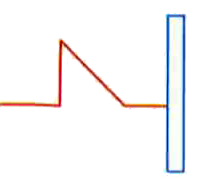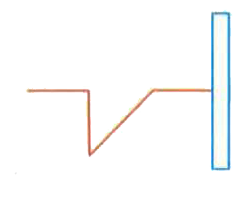A pulse is a wave
of high duration
of short duration
which travels in vacuum only
which travels in solids only
The correct Answer is:B
Step-by-Step Solution:
1. Understanding the Definition of a Pulse:
A pulse is a single disturbance that travels through a medium. It is a short duration wave that results from a sudden change in the medium.
2. Generating a Pulse:
To visualize a pulse, imagine a stretched wire. If you hold one end of the wire, pull it slightly, and then release it, a pulse is generated. This pulse will then propagate along the wire.
3. Characteristics of a Pulse:
- Duration: A pulse is characterized by its short duration. It does not last long; it travels through the medium for a brief moment before dissipating.
- Propagation: The pulse travels through the medium (in this case, the wire) and can end at the other end or somewhere in the middle if the wire is long enough.
4. Medium Requirement:
Contrary to some misconceptions, a pulse does not require a medium to travel in a vacuum. However, in practical scenarios, it is often observed in solids, liquids, and gases.
5. Conclusion:
A pulse is a wave of short duration that propagates through a medium. It is important to note that it does not have a long duration and can travel through various mediums, including solids.
A pulse is a single disturbance that travels through a medium. It is a short duration wave that results from a sudden change in the medium.
To visualize a pulse, imagine a stretched wire. If you hold one end of the wire, pull it slightly, and then release it, a pulse is generated. This pulse will then propagate along the wire.
- Duration: A pulse is characterized by its short duration. It does not last long; it travels through the medium for a brief moment before dissipating.
- Propagation: The pulse travels through the medium (in this case, the wire) and can end at the other end or somewhere in the middle if the wire is long enough.
Contrary to some misconceptions, a pulse does not require a medium to travel in a vacuum. However, in practical scenarios, it is often observed in solids, liquids, and gases.
A pulse is a wave of short duration that propagates through a medium. It is important to note that it does not have a long duration and can travel through various mediums, including solids.
Topper's Solved these Questions
- WAVE MOTION AND SOUND BOOK - MCGROW HILL PUBLICATIONCHAPTER - WAVE MOTION AND SOUND EXERCISE - HIGH ORDER THINKING QUESTIONS
22 Videos
- SOURCES OF ENERGY BOOK - MCGROW HILL PUBLICATIONCHAPTER - SOURCES OF ENERGY EXERCISE - ELEMENTARY QUESTIONS
82 Videos
- WORK AND ENERGYBOOK - MCGROW HILL PUBLICATIONCHAPTER - WORK AND ENERGYEXERCISE - HIGHER ORDER THINKING QUESTIONS
29 Videos
Similar Questions
A nerve pulse is a wave pulse that travels along a nerve, typically at a speed of 50m/s. If the pulse sweeps past one point in the nerve from t = 0 to t = 2 ms, during what time interval will it pass a point in the nerve 1m away ?
View SolutionA pulse in a rope approaches a solid wall and it gets reflected from it The wave pulse after reflection is best represented by
View Solution
Knowledge Check
A pulse of a wave train travel s along a stretched string and reaches the fixed end of the string and reaches the fixed end of the string.it will be reflected back with
Aa phase change of 180∘ with velocity reversedBthe same phase as the incident pulse with no reversal of velocityCa phase change of 180∘ with no reveral of velocityDthe same phase as the incident pulse but with velocity reversedA pulse in a rope approaches a solid wall and it gets reflected from it

The wave pulse after reflection is best represented byA B
B C
C D
D

Two pulses are travelling along a string in opposite directions towards each other as shown in the figure. If the wave velocity is 2cm/s and the pulses are 6 cm apart, then after 1.5sec, the energy stored in the string will be (Assume shapes of pulses to be similar)Akinetic energy onlyBpotential energy onlyCkinetic energy as well as potential energyDnone of these
The wave function of a pulse is given by y=5(4x+6t)2 where x and y are in metre and t is in second :-
(i) Identify the direction of propagation
(ii) Determine the wave velocity of the pulse
View SolutionA travelling wave pulse is given by y=105+(x+2t)2
Here, xandy are in meter and t in second. In which direction and with what velocity is the pulse propagation. What is the ampitude of pulse?
View SolutionTwo wave pulses travel in opposite directions on a string and approach each other. The shape of one pulse is inverted with respect to the other
View SolutionThe situation of a wave pulse is given as y=0.8(4x+5t)+4 the amplitude and velocity of pulse are
View SolutionThe wave function of a pulse is given by y=5(4x+6t)2 where x and y are in metre and t is in second :-
(i) Identify the direction of propagation
(ii) Determine the wave velocity of the pulse
View Solution
